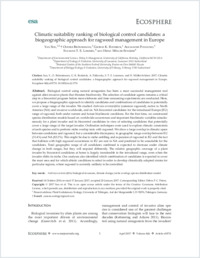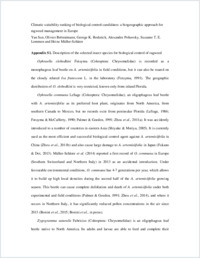Climatic suitability ranking of biological control candidates: a biogeographic approach for ragweed management in Europe
- Sun, Yan Department of Environmental Science, Policy & Management, University of California, Berkeley, California, USA - Plant Evolutionary Ecology, University of Tübingen, Tubingen, Germany
- Brönnimann, Olivier Department of Ecology & Evolution, University of Lausanne, Switzerland
- Roderick, George K. Department of Environmental Science, Policy & Management, University of California, Berkeley, California, USA
- Poltavsky, Alexander Botanical Garden of the Southern Federal University, Rostov-on-Don, Russia
- Lommen, Suzanne T. E. Department of Biology/Ecology & Evolution, University of Fribourg, Switzerland
- Müller-Schärer, Heinz Department of Biology/Ecology & Evolution, University of Fribourg, Switzerland
-
01.04.2017
Published in:
- Ecosphere. - 2017, vol. 8, no. 4, p. e01731
Ambrosia artemisiifolia
biological invasions
climate change
niche overlap
species distribution model
English
Biological control using natural antagonists has been a most successful management tool against alien invasive plants that threaten biodiversity. The selection of candidate agents remains a critical step in a biocontrol program before more elaborate and time- consuming experiments are conducted. Here, we propose a biogeographic approach to identify candidates and combinations of candidates to potentially cover a large range of the invader. We studied Ambrosia artemisiifolia (common ragweed), native to North America (NA) and invasive worldwide, and six NA biocontrol candidates for the introduced Europe (EU) range of ragweed, both under current and future bioclimatic conditions. For the first time, we constructed species distribution models based on worldwide occurrences and important bioclimatic variables simultaneously for a plant invader and its biocontrol candidates in view of selecting candidates that potentially cover a large range of the target invader. Ordination techniques were used to explore climatic constraints of each species and to perform niche overlap tests with ragweed. We show a large overlap in climatic space between candidates and ragweed, but a considerable discrepancy in geographic range overlap between EU (31.4%) and NA (83.3%). This might be due to niche unfilling and expansion of ragweed in EU and the fact that habitats with high ragweed occurrences in EU are rare in NA and predicted to be unsuitable for the candidates. Total geographic range of all candidates combined is expected to decrease under climate change in both ranges, but they will respond differently. The relative geographic coverage of a plant invader by biocontrol candidates at home is largely transferable to the introduced range, even when the invader shifts its niche. Our analyses also identified which combination of candidates is expected to cover the most area and for which abiotic conditions to select in order to develop climatically adapted strains for particular regions, where ragweed is currently unlikely to be controlled.
- Faculty
- Faculté des sciences et de médecine
- Department
- Département de Biologie
- Language
-
- English
- Classification
- Ecology and biodeversity
- License
- License undefined
- Identifiers
-
- RERO DOC 288901
- DOI 10.1002/ecs2.1731
- Persistent URL
- https://folia.unifr.ch/unifr/documents/305560
Other files
Statistics
Document views: 98
File downloads:
- mue_csr.pdf: 116
- mue_csr_sm.pdf: 78

